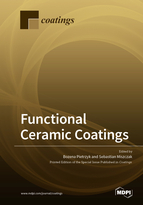Functional Ceramic Coatings
A special issue of Coatings (ISSN 2079-6412).
Deadline for manuscript submissions: closed (30 September 2020) | Viewed by 54564
Special Issue Editors
Interests: materials science; surface engineering; coatings; ceramics; biomaterials; composite coatings; photocatalytic coatings; nanomaterials; protective coatings; deposition methods; sol-gel
Special Issues, Collections and Topics in MDPI journals
Interests: thin films; coatings; sol-gel; ceramics; materials engineering; materials characterization
Special Issues, Collections and Topics in MDPI journals
Special Issue Information
Dear Colleagues,
The properties of materials result, not only from structure and physico-chemical characteristics, but also from the properties of their surfaces. One of the ways of modifying material surface properties is by using deposition of coatings. Coatings can significantly change functionalities and applications of substrate materials.
Ceramics are an important group of coating materials with a wide range of controllable properties, such as electrical conductivity, photocatalytic and catalytic behavior, hardness, biocompatibility, surface energy, corrosion resistance, etc. Ceramic coatings contribute to the development of useful functionalities of materials, which are key factors for the advancement of science and technology.
Understanding of the relationship between the structure and the properties of ceramic coatings and thin films is essential for further development of new applications of materials. An adjustment in structure and morphology of a coating or thin film, in order to modify its properties, can be used to add new functionalities and improved behavior of materials and devices.
The scope of the Special Issue “Functional Ceramic Coatings” is the presentation of innovative methods in fabrication, characterization and properties of ceramic coatings and thin films with an emphasis on influence of structure and morphology on their properties and potential applications.
In particular, the topics of interest include, but are not limited to:
- New deposition processes including: liquid-based deposition, magnetron sputtering, PVD, CVD and their derivatives (such as PECVD, ALD, PLD, etc.), as well as hybrid methods.
- Ceramic coatings and thin films for functional application such as optical, electrical, tribological, catalytical/photocatalytical, magnetic, antibacterial, biomedical, protective, etc.
- Characterization methods to determine the properties of ceramic coatings and thin films
- New trends in ceramic coatings and films
Dr. Bozena Pietrzyk
Dr. Sebastian Miszczak
Guest Editors
Manuscript Submission Information
Manuscripts should be submitted online at www.mdpi.com by registering and logging in to this website. Once you are registered, click here to go to the submission form. Manuscripts can be submitted until the deadline. All submissions that pass pre-check are peer-reviewed. Accepted papers will be published continuously in the journal (as soon as accepted) and will be listed together on the special issue website. Research articles, review articles as well as short communications are invited. For planned papers, a title and short abstract (about 100 words) can be sent to the Editorial Office for announcement on this website.
Submitted manuscripts should not have been published previously, nor be under consideration for publication elsewhere (except conference proceedings papers). All manuscripts are thoroughly refereed through a single-blind peer-review process. A guide for authors and other relevant information for submission of manuscripts is available on the Instructions for Authors page. Coatings is an international peer-reviewed open access monthly journal published by MDPI.
Please visit the Instructions for Authors page before submitting a manuscript. The Article Processing Charge (APC) for publication in this open access journal is 2600 CHF (Swiss Francs). Submitted papers should be well formatted and use good English. Authors may use MDPI's English editing service prior to publication or during author revisions.
Related Special Issue
- Functional Ceramic Coatings II in Coatings (2 articles)






